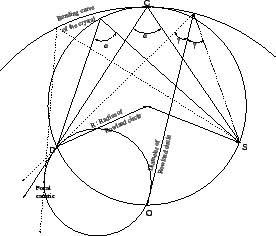The scattering of X-rays of wavelength ![]() on crystal planes with
a spacing d is described by the Bragg reflection condition
on crystal planes with
a spacing d is described by the Bragg reflection condition
The method of Bragg reflection for energy analysis is based on the extreme angular
sensitivity. Values of several ![]() for
for ![]() are typical
for the crystals used in the present experiment. With flat crystals, however,
in general only a small part of the crystal surface fulfills the Bragg condition.
In the case of the present experiment with a typical distance of
are typical
for the crystals used in the present experiment. With flat crystals, however,
in general only a small part of the crystal surface fulfills the Bragg condition.
In the case of the present experiment with a typical distance of ![]() between X-ray source and Bragg crystal only a stripe with a width of a little
less than a
between X-ray source and Bragg crystal only a stripe with a width of a little
less than a ![]() would be usable for one wavelength. In order to reach
a higher rate of the X-rays the crystals are bent to an appropriate curvature.
For the moment we consider only horizontal cylindrical bending of a crystal
whose deflection planes are parallel to the surface (``symmetrically cut crystals'').
would be usable for one wavelength. In order to reach
a higher rate of the X-rays the crystals are bent to an appropriate curvature.
For the moment we consider only horizontal cylindrical bending of a crystal
whose deflection planes are parallel to the surface (``symmetrically cut crystals'').
The use of bent crystals has long be delayed as a conceptional difficulty arises because of the geometrical impossibility to satisfy simultaneously the two requirements implicit to the Bragg law. These two conditions are:
 |
|
Figure 10:
Rowland circle and Bragg angles. The Bragg condition requires
reflection at the boundary of a circle with radius of the Rowland circle. D
and S denote the position of detector and source, respectively. At C the Bragg
crystal is mounted. It has a curvature radius
|
While the conditions 1. and 2. cannot be simulteneously satisfied
exactly, they can be satisfied approximately at the cost of aberration. Bending
the crystal with
![]() (
( ![]() being the Rowland radius)
as proposed by H. H. Johann [70] leads to a geometrical aberration which
depends on the finite width of the crystal. The broadening can still be tolerated
as long as the contribution of the geometrical aberration is smaller than the
intrinsic resolution of the crystals. This is the case for small enough crystals
as used in the present experiment.
being the Rowland radius)
as proposed by H. H. Johann [70] leads to a geometrical aberration which
depends on the finite width of the crystal. The broadening can still be tolerated
as long as the contribution of the geometrical aberration is smaller than the
intrinsic resolution of the crystals. This is the case for small enough crystals
as used in the present experiment.
It should be mentioned that T. Johannson [88] proposed to grind
the surface of a crystal bent to a radius
![]() with a grinding
radius
with a grinding
radius ![]() . In this way, the crystal surface is tangent to the Rowland
circle and the reflecting planes still lie on a cylinder with radius
. In this way, the crystal surface is tangent to the Rowland
circle and the reflecting planes still lie on a cylinder with radius
![]() .
In the plane the Johannson geometry fulfills the focussing conditions independent
of the extension of the crystal. The machining difficulties of such a procedure
are tremendous.
.
In the plane the Johannson geometry fulfills the focussing conditions independent
of the extension of the crystal. The machining difficulties of such a procedure
are tremendous.